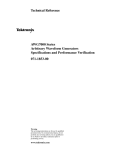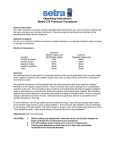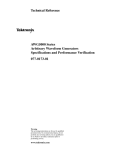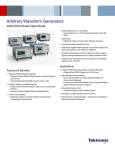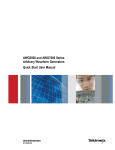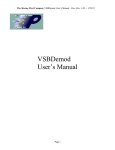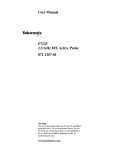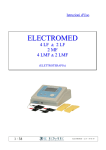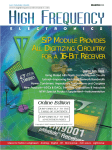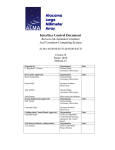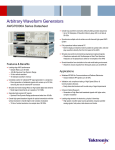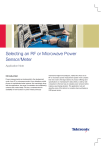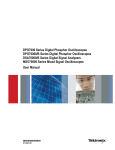Download AWG7000C Series Arbitrary Waveform Generators Specifications
Transcript
xx ZZZ AWG7000C Series Arbitrary Waveform Generators Specifications and Performance Verification Technical Reference *P077045603* 077-0456-03 xx ZZZ AWG7000C Series Arbitrary Waveform Generators Specifications and Performance Verification Technical Reference Warning The servicing instructions are for use by qualified personnel only. To avoid personal injury, do not perform any servicing unless you are qualified to do so. Refer to all safety summaries before performing service. www.tektronix.com 077-0456-03 Copyright © Tektronix. All rights reserved. Licensed software products are owned by Tektronix or its subsidiaries or suppliers, and are protected by national copyright laws and international treaty provisions. Tektronix products are covered by U.S. and foreign patents, issued and pending. Information in this publication supersedes that in all previously published material. Specifications and price change privileges reserved. TEKTRONIX and TEK are registered trademarks of Tektronix, Inc. TekLink is a trademark of Tektronix, Inc. Contacting Tektronix Tektronix, Inc. 14150 SW Karl Braun Drive P.O. Box 500 Beaverton, OR 97077 USA For product information, sales, service, and technical support: In North America, call 1-800-833-9200. Worldwide, visit www.tektronix.com to find contacts in your area. Warranty Tektronix warrants that this product will be free from defects in materials and workmanship for a period of one (1) year from the date of shipment. If any such product proves defective during this warranty period, Tektronix, at its option, either will repair the defective product without charge for parts and labor, or will provide a replacement in exchange for the defective product. Parts, modules and replacement products used by Tektronix for warranty work may be new or reconditioned to like new performance. All replaced parts, modules and products become the property of Tektronix. In order to obtain service under this warranty, Customer must notify Tektronix of the defect before the expiration of the warranty period and make suitable arrangements for the performance of service. Customer shall be responsible for packaging and shipping the defective product to the service center designated by Tektronix, with shipping charges prepaid. Tektronix shall pay for the return of the product to Customer if the shipment is to a location within the country in which the Tektronix service center is located. Customer shall be responsible for paying all shipping charges, duties, taxes, and any other charges for products returned to any other locations. This warranty shall not apply to any defect, failure or damage caused by improper use or improper or inadequate maintenance and care. Tektronix shall not be obligated to furnish service under this warranty a) to repair damage resulting from attempts by personnel other than Tektronix representatives to install, repair or service the product; b) to repair damage resulting from improper use or connection to incompatible equipment; c) to repair any damage or malfunction caused by the use of non-Tektronix supplies; or d) to service a product that has been modified or integrated with other products when the effect of such modification or integration increases the time or difficulty of servicing the product. THIS WARRANTY IS GIVEN BY TEKTRONIX WITH RESPECT TO THE PRODUCT IN LIEU OF ANY OTHER WARRANTIES, EXPRESS OR IMPLIED. TEKTRONIX AND ITS VENDORS DISCLAIM ANY IMPLIED WARRANTIES OF MERCHANTABILITY OR FITNESS FOR A PARTICULAR PURPOSE. TEKTRONIX' RESPONSIBILITY TO REPAIR OR REPLACE DEFECTIVE PRODUCTS IS THE SOLE AND EXCLUSIVE REMEDY PROVIDED TO THE CUSTOMER FOR BREACH OF THIS WARRANTY. TEKTRONIX AND ITS VENDORS WILL NOT BE LIABLE FOR ANY INDIRECT, SPECIAL, INCIDENTAL, OR CONSEQUENTIAL DAMAGES IRRESPECTIVE OF WHETHER TEKTRONIX OR THE VENDOR HAS ADVANCE NOTICE OF THE POSSIBILITY OF SUCH DAMAGES. [W2 – 15AUG04] Table of Contents General Safety Summary ......................................................................................... Service Safety Summary.......................................................................................... Preface ............................................................................................................. Related Documents .......................................................................................... Specifications ....................................................................................................... Performance Conditions ...................................................................................... Electrical Specifications....................................................................................... Mechanical (Physical) Characteristics...................................................................... Environmental Characteristics .............................................................................. Performance Verification Procedures............................................................................ Brief Procedures ................................................................................................... Diagnostics .................................................................................................... Calibration ..................................................................................................... Functional Test ................................................................................................ Performance Tests ................................................................................................. Prerequisites ................................................................................................... Required Equipment.......................................................................................... Test Record .................................................................................................... 10 MHz Reference Frequency Accuracy................................................................... Analog Offset Accuracy ..................................................................................... Analog Amplitude Accuracy ................................................................................ Analog Harmonic Distortion ................................................................................ Analog Non-Harmonic Spurious Signal.................................................................... Analog Phase Noise .......................................................................................... Marker High and Low Level Accuracy .................................................................... Marker Output Delay Accuracy ............................................................................. DC Output Voltage Accuracy ............................................................................... AWG7000C Series Arbitrary Waveform Generators Technical Reference iv vi vii vii 1 1 2 15 16 17 18 18 19 20 23 23 23 25 33 34 36 39 41 43 45 48 50 i Table of Contents List of Figures Figure 1: Diagnostics dialog box ................................................................................ Figure 2: Calibration dialog box ................................................................................. Figure 3: Equipment connections for checking the analog and marker outputs ............................ Figure 4: Output waveform from the Analog, Mkr 1, and Mkr 2 connectors .............................. Figure 5: Equipment connection for verifying the 10 MHz reference frequency accuracy ............... Figure 6: Equipment connection for measuring the termination resistance................................. Figure 7: Equipment connection for verifying the analog offset accuracy.................................. Figure 8: Equipment connections for verifying the analog harmonic distortion ........................... Figure 9: Equipment connections for verifying the non-harmonic spurious signal ........................ Figure 10: Equipment connections for verifying the analog phase noise ................................... Figure 11: Example of the analog phase noise measurement................................................. Figure 12: Equipment connection for verifying the marker high and low level accuracy................. Figure 13: Equipment connections for verifying the marker output delay accuracy....................... Figure 14: Equipment connection for verifying the DC output voltage accuracy.......................... ii 18 19 21 22 33 34 35 39 41 43 45 46 49 51 AWG7000C Series Arbitrary Waveform Generators Technical Reference Table of Contents List of Tables Table 1: Run mode ................................................................................................. 2 Table 2: Arbitrary waveform ...................................................................................... 2 Table 3: Clock generator........................................................................................... 3 Table 4: Trigger generator ......................................................................................... 4 Table 5: Inter-channel skew control .............................................................................. 4 Table 6: Interleave adjustment (Option 06)...................................................................... 4 Table 7: Waveform rotation control for analog output ......................................................... 5 Table 8: Analog output (Standard) ............................................................................... 5 Table 9: Analog output (Option 02 and 06) ..................................................................... 7 Table 10: Interleave analog output (Option 06) ................................................................. 8 Table 11: Marker output ........................................................................................... 9 Table 12: Trigger and gate input ................................................................................. 10 Table 13: Event input ............................................................................................. 11 Table 14: Reference clock input ................................................................................. 12 Table 15: Oscillator (External clock) input ..................................................................... 12 Table 16: DC output............................................................................................... 12 Table 17: Dynamic Jump In connector.......................................................................... 13 Table 18: Synchronization clock out port....................................................................... 14 Table 19: 10 MHz clock output .................................................................................. 14 Table 20: TekLink port............................................................................................ 14 Table 21: CPU module and peripheral devices................................................................. 14 Table 22: Display .................................................................................................. 15 Table 23: Power supply ........................................................................................... 15 Table 24: Mechanical characteristics............................................................................ 15 Table 25: Environmental characteristics ........................................................................ 16 Table 26: Required equipment ................................................................................... 23 Table 27: Test waveforms ........................................................................................ 24 Table 28: Analog offset accuracy................................................................................ 35 Table 29: Analog amplitude accuracy........................................................................... 37 Table 30: Analog harmonic distortion........................................................................... 40 Table 31: Analog non-harmonic spurious signal............................................................... 42 Table 32: Analog phase noise .................................................................................... 44 Table 33: Marker High and Low level accuracy ............................................................... 46 Table 34: DC output voltage accuracy .......................................................................... 51 AWG7000C Series Arbitrary Waveform Generators Technical Reference iii General Safety Summary General Safety Summary Review the following safety precautions to avoid injury and prevent damage to this product or any products connected to it. To avoid potential hazards, use this product only as specified. Only qualified personnel should perform service procedures. To Avoid Fire or Personal Injury Use proper power cord. Use only the power cord specified for this product and certified for the country of use. Ground the product. This product is grounded through the grounding conductor of the power cord. To avoid electric shock, the grounding conductor must be connected to earth ground. Before making connections to the input or output terminals of the product, ensure that the product is properly grounded. Observe all terminal ratings. To avoid fire or shock hazard, observe all ratings and markings on the product. Consult the product manual for further ratings information before making connections to the product. Do not apply a potential to any terminal, including the common terminal, that exceeds the maximum rating of that terminal. Power disconnect. The power cord disconnects the product from the power source. Do not block the power cord; it must remain accessible to the user at all times. Do not operate without covers. Do not operate this product with covers or panels removed. Do not operate with suspected failures. If you suspect that there is damage to this product, have it inspected by qualified service personnel. Avoid exposed circuitry. Do not touch exposed connections and components when power is present. Do not operate in wet/damp conditions. Do not operate in an explosive atmosphere. Keep product surfaces clean and dry. Provide proper ventilation. Refer to the manual's installation instructions for details on installing the product so it has proper ventilation. iv AWG7000C Series Arbitrary Waveform Generators Technical Reference General Safety Summary Terms in This Manual These terms may appear in this manual: WARNING. Warning statements identify conditions or practices that could result in injury or loss of life. CAUTION. Caution statements identify conditions or practices that could result in damage to this product or other property. Symbols and Terms on the Product These terms may appear on the product: DANGER indicates an injury hazard immediately accessible as you read the marking. WARNING indicates an injury hazard not immediately accessible as you read the marking. CAUTION indicates a hazard to property including the product. The following symbol(s) may appear on the product: AWG7000C Series Arbitrary Waveform Generators Technical Reference v Service Safety Summary Service Safety Summary Only qualified personnel should perform service procedures. Read this Service Safety Summary and the General Safety Summary before performing any service procedures. Do Not Service Alone. Do not perform internal service or adjustments of this product unless another person capable of rendering first aid and resuscitation is present. Disconnect Power. To avoid electric shock, switch off the instrument power, then disconnect the power cord from the mains power. Use Care When Servicing With Power On. Dangerous voltages or currents may exist in this product. Disconnect power, remove battery (if applicable), and disconnect test leads before removing protective panels, soldering, or replacing components. To avoid electric shock, do not touch exposed connections. vi AWG7000C Series Arbitrary Waveform Generators Technical Reference Preface This manual contains specifications and performance verification procedures for the AWG7000C Series Arbitrary Waveform Generators. Related Documents The following user documents are also available for this product: AWG5000 and AWG7000 Series Arbitrary Waveform Generators Quick Start User Manual. This document describes the functions and use of the instrument. AWG7000 Series Arbitrary Waveform Generators Service Manual. This is a PDF only manual that provides module-level service information. It can be downloaded from the Tektronix Web site. AWG7000C Series Arbitrary Waveform Generators Technical Reference vii Preface viii AWG7000C Series Arbitrary Waveform Generators Technical Reference Specifications This section contains the specifications for the instruments. All specifications are guaranteed unless noted as (Typical). Typical specifications are provided for your convenience but are not guaranteed. Specifications that are symbol are checked in this manual. marked with the Performance Conditions To meet specifications, the following conditions must be met: The instrument must have been calibrated/adjusted at an ambient temperature between +20 °C and +30 °C. The instrument must be operating within the environmental limits. (See Table 25 on page 16.) The instrument must be powered from a source that meets the specifications. (See Table 23 on page 15.) The instrument must have been operating continuously for at least 20 minutes within the specified operating temperature range. AWG7000C Series Arbitrary Waveform Generators Technical Reference 1 Specifications Electrical Specifications Table 1: Run mode Characteristics Description Continuous mode An arbitrary waveform is output continuously. Triggered mode An arbitrary waveform is output only once when a trigger signal is applied. After the waveform is output, the instrument waits for the next trigger signal. Gated mode An arbitrary waveform is output only when a gate signal is asserted. The waveform output is repeated while the gate signal stays asserted. When the gate signal is deasserted, the waveform output stops immediately. Sequence mode Without Option 08 Sequence switching with wait trigger Option 08 Fast sequence switching Table 2: Arbitrary waveform Characteristics Description Waveform length Without Option 01 1 to 32,400,000 points (Interleave is off) 2 to 64,800,000 points (Option 06, Interleave is on) With Option 01 1 to 64,800,000 points (Interleave is off) 2 to 129,600,000 points (Interleave is on) Hardware limitation 960 points minimum (Interleave is off) 1920 points minimum (Option 06, Interleave is on) Waveform granularity Hardware limitation 1 point 4 points (AWG7082C, AWG7122C) 8 points (AWG7082C, AWG7122C Option 06, Interleave on) DAC resolution 10 bits or 8 bits selectable (when the 10 bits DAC mode is selected, marker output is disabled.) Number of waveforms Up to 32,000 waveforms (predefined waveforms are not included) Sequence length 1 to 16,000 steps Sequence controls Without Option 08 Repeat count, Wait-for-Trigger (On only), Go-to-N, and Jump are available Option 08 Repeat count, Wait-for-Trigger (On or Off), Go-to-N, and Jump are available Repeat count 1 to 65,536 or infinite (all channels operate the same sequence) Jump timing Synchronous or Asynchronous selectable 2 AWG7000C Series Arbitrary Waveform Generators Technical Reference Specifications Table 2: Arbitrary waveform (cont.) Characteristics Description Sequence switching time (Typical) AWG7000C series 8 ns (AWG7082C) 106 μs (AWG7122C) AWG7000C series with Option 02 8 ns (AWG7082C) 106 μs (AWG7122C) AWG7000C series with Option 06 160 μs (AWG7082C) 106 μs (AWG7122C) AWG7000C series with Option 08 312 ps (AWG7082C) 208 ps (AWG7122C) AWG7000C series with Option 02 and Option 08 312 ps (AWG7082C) 208 ps (AWG7122C) AWG7000C series with Option 06 and Option 08 156 ps (AWG7082C) 104 ps (AWG7122C) Table 3: Clock generator Characteristics Description Sampling rate control Range AWG7122C 10 MS/s to 12 GS/s (Interleave is off) AWG7122C with Option 06 1 12 GS/s to 24 GS/s (Interleave is on) AWG7082C 10 MS/s to 8 GS/s (Interleave is off) AWG7082C with Option 06 1 8 GS/s to 16 GS/s (Interleave is on) Resolution Internal clock frequency Internal clock frequency accuracy (Typical) Reference oscillator accuracy Reference oscillator aging (Typical) 1 8 digits Within ± (1 ppm + aging) Aging: within ± 1 ppm/year Within ± (1 ppm + aging) Aging: within ± 1 ppm/year Interleaving is applied to analog output. When interleaving is on, marker data with even numbers will be output. AWG7000C Series Arbitrary Waveform Generators Technical Reference 3 Specifications Table 4: Trigger generator Characteristics Trigger 1 Description rate 1 Range 1.0 μs to 10.0 s Resolution 0.1 μs minimum Accuracy Same as the reference oscillator Trigger is ignored when all the following conditions are met: • Instrument type: AWG7122C with Option 06, without Option 08 • Run mode: Sequence • Interleave: On Table 5: Inter-channel skew control Characteristics Description Skew control Range –100 ps to +100 ps Resolution Skew accuracy 1 1 ps (Typical) 1 ± (10% of effective skew setting +10 ps) Direct output mode on standard instrument Effective skew setting is the absolute value of the difference between the skew setting on channels. Table 6: Interleave adjustment (Option 06) Characteristics Description Phase adjustment Range –180 ° to +180 ° Resolution 0.1 ° Amplitude adjustment 1 4 At amplitude setting 0.75 Vp-p Range 1 –0.25 Vp-p to +0.25 Vp-p Resolution 0.001 V Range depends on the amplitude settings. (Amplitude setting + Adjustment) and (Amplitude setting – Adjustment) should be within the following range: • 0.5 Vp-p to 1.0 Vp-p with zeroing off • 0.25 Vp-p to 0.5 Vp-p with zeroing on AWG7000C Series Arbitrary Waveform Generators Technical Reference Specifications Table 7: Waveform rotation control for analog output Characteristics Description Phase control Range CVR Gain stability is ±0.1% if measured within 25° of the temperature at factory calibration Resolution CVR Gain linearity is ±0.2%. Perform an automatic sweep and take voltage measurements at every DAC value. Time control Range –1/2 period to +1/2 period of waveform Resolution 0.1 ps Point control Range –50% to +50% of waveform Resolution 0.001 points Table 8: Analog output (Standard) Characteristics Description Connector type SMA on front panel Type of output (+) and (–) complementary output Output impedance 50 Ω Amplitude controls Range Normal mode 50 mV to 2.0 Vp-p Direct D/A mode 50 mV to 1.0 Vp-p Resolution 1 mV Offset controls Range Normal mode –0.5 V to +0.5 V Direct D/A mode N/A Resolution 1 mV Amplitude accuracy DC accuracy: within ± (3% of amplitude + 2 mV) at offset = 0V Offset accuracy DC accuracy: within ± (2% of amplitude + 10 mV) at minimum amplitude Bandwidth (Typical) Normal mode 750 MHz, at -3 dB Direct D/A mode 3.5 GHz, at -3 dB Rise/fall time (Typical) Normal mode 350 ps (20% to 80%), when amplitude = 2.0 Vp-p, offset = 0 V Direct D/A mode 75 ps (20% to 80%), when amplitude = 1.0 Vp-p Overshoot (Typical) < 10%, when amplitude = 1.0 Vp-p AWG7000C Series Arbitrary Waveform Generators Technical Reference 5 Specifications Table 8: Analog output (Standard) (cont.) Characteristics Description Low pass filter Normal mode 50 MHz, 200 MHz, Through (Bessel type) Direct D/A mode N/A Delay from marker (Typical) 10.15 ns ±0.15 ns: low pass = 50 MHz 4.05 ns ±0.05 ns: low pass = 200 MHz 2.26 ns ±0.04 ns: low pass = Through 0.585 ns ±0.045 ns: Direct output mode (when amplitude = 1.0 Vp-p, offset = 0 V) Skew between (+) and (–) outputs (Typical) < 20 ps (direct D/A mode) ON/OFF control Output relay is available for each channel. The control is common to the complementary output. Harmonic distortion AWG7122C Normal mode < –35 dBc, when clock = 12 GS/s, signal = 375 MHz AWG7122C Direct D/A mode < –42 dBc, when clock = 12 GS/s, signal = 375 MHz AWG7082C Normal mode < -37 dBc, when clock = 8 GS/s, signal = 250 MHz AWG7082C Direct D/A mode < -43 dBc, when clock = 8 GS/s, signal = 250 MHz Non-harmonic spurious Amplitude = 1.0 Vp-p, offset = 0 V, DAC resolution = 10 bits, measured with 32-point sine waveform, measurement range is DC to sampling_frequency ÷ 2 AWG7122C < –50 dBc, DC to 6 GHz, when clock = 12 GS/s, signal = 375 MHz AWG7082C < -50 dBc, DC to 4 GHz, when clock = 8 GS/s, signal = 250 MHz SFDR (Typical) Normal output mode, amplitude = 1.0 Vp-p, offset = 0 V, DAC resolution = 10 bits, measurement range is DC to sampling_frequency ÷ 2 AWG7122C 43 dBc, when clock = 12 GS/s, signal = 375 MHz AWG7122C, AWG7082C 45 dBc, when clock = 8 GS/s, signal = 250 MHz Phase noise Normal output mode, amplitude = 1.0 Vp-p, offset = 0 V, DAC resolution = 10 bits, measured with 32-point sine waveform AWG7122C < –90 dBc/Hz at 10 kHz offset, when clock = 12 GS/s, signal = 375 MHz AWG7082C < -90 dBc/Hz at 10 kHz offset, when clock = 8 GS/s, signal = 250 MHz Random jitter on clock pattern (Typical) Using 0101... clock pattern, amplitude = 1.0 Vp-p, offset = 0 V Normal mode 1.6 psRMS Direct D/A mode 0.45 psRMS Total jitter on random pattern (Typical) Normal mode Direct D/A mode Amplitude flatness (Typical) 6 Amplitude = 1.0 Vp-p, offset = 0 V, DAC resolution = 10 bits, measured with 32-point sine waveform, defined up to 5th harmonic Using PN15 pattern, amplitude = 1.0 Vp-p, offset = 0 V, measured at bit error rate = 1e–12 50 ps p-p at 500 MS/s 30 ps p-p from 1 GS/s to 6 GS/s ±2 db from 50 MHz to 3.5 GHz Measured with Direct Output at 50 MHz increments, mathematically corrected for sin(x)/x roll-off AWG7000C Series Arbitrary Waveform Generators Technical Reference Specifications Table 9: Analog output (Option 02 and 06) Characteristics Description Connector type SMA on front panel Type of output (+) and (–) complementary outputs Output impedance 50 Ω Amplitude controls Range 0.5 V to 1.0 Vp-p Resolution 1 mV Amplitude accuracy DC accuracy: Within ± (2% of amplitude + 2 mV) at offset = 0V DC offset Within ± 10 mV Bandwidth (Typical) 7.5 GHz at –3 dB Rise/fall time (Typical) 35 ps (20% to 80%), when amplitude = 1.0 Vp-p Overshoot (Typical) < 3%, when amplitude = 1.0 Vp-p Delay from marker (Typical) Option 02: 0.185 ns ±0.05 ns, when amplitude = 1.0 Vp-p Option 06 1.025 ns ±0.05 ns, when amplitude = 1.0 Vp-p Skew between (+) and (–) outputs (Typical) < 12 ps ON/OFF control Output relay is available for each channel. The control is common to the complementary output. Harmonic distortion Amplitude = 1.0 Vp-p, DAC resolution = 10 bit, measured with 32-point sine waveform, defined up to 5th harmonic AWG7122C < -42 dBc, when clock = 12 GS/s, signal = 375 MHz AWG7082C < -44 dBc, when clock = 8 GS/s, signal = 250 MHz Non-harmonic spurious Amplitude = 1.0 Vp-p, resolution = 10 bits, measured with 32-point sine waveform, measurement range is DC to sampling frequency ÷ 2 AWG7122C < -50 dBc, DC to 6 GHz, when clock = 12 GS/s, signa l =375 MHz AWG7082C < -50 dBc, DC to 4 GHz, when clock = 8 GS/s, signal = 250 MHz SFDR (Typical) Amplitude = 1.0 Vp-p, DAC resolution = 10 bits, measurement range is DC to sampling frequency ÷ 2 including harmonics AWG7122C 44 dBc, when clock = 12 GS/s, signal = 375 MHz AWG7082C 46 dBc, when clock = 8 GS/s, signal = 250 MHz Phase noise Amplitude = 1.0 Vp-p, DAC resolution = 10 bit, measured with 32 point sine waveform AWG7122C < -90 dBc/Hz at 10 kHz offset, when clock = 12 GS/s, signal = 375 MHz AWG7082C < -90 dBc/Hz at 10 kHz offset, when clock = 8 GS/s, signal = 250 MHz Random jitter on clock pattern (Typical) 0.4 psRMS, using 0101... clock pattern, amplitude = 1.0 Vp-p, measured for five minutes Total jitter on random pattern (Typical) 20 psp-p from 2 GS/s to 12 GS/s, PN15 pattern, amplitude = 1.0 Vp-p, measured at bit error rate = 1e-12 for five minutes Amplitude flatness (Typical) ±2 dB from 50 MHz to 4.8 GHz Measured at 50 MHz increments, mathematically corrected for sin(x)/x roll-off AWG7000C Series Arbitrary Waveform Generators Technical Reference 7 Specifications Table 10: Interleave analog output (Option 06) Characteristics Description Connector type SMA on front panel Type of output (+) and (–) complementary output Output impedance 50 Ω Zeroing control Zeroing On and Off is selectable. Amplitude controls Range 0.25 V to 0.5 Vp-p, Zeroing = On 0.5 V to 1.0 Vp-p, Zeroing = Off Resolution 1 mV Amplitude accuracy (Typical) DC offset DC accuracy at offset = 0 V Within ± (40% of amplitude + 2 mV), Zeroing = On Within ± (8% of amplitude + 2 mV), Zeroing = Off Within ± 10 mV Bandwidth (Typical) 7.5 GHz at –3 dB, when amplitude = 0.5 Vp-p, zeroing = On Rise/fall time (Typical) 35 ps (20% to 80%), when amplitude = 0.5 Vp-p, zeroing = On Delay from marker (Typical) 0.86 ns ±0.05 ns when amplitude = 0.5 Vp-p, zeroing = On Skew between (+) and (–) outputs (Typical) < 12 ps ON/OFF control Output relay is available for each channel. The control is common to the complementary output. Harmonic distortion (Typical) Measured with 32-point sine waveform, defined up to 5th harmonics AWG7122C Zeroing = On < –38 dBc, when amplitude = 0.5 Vp-p, clock = 24 GS/s, signal = 750 MHz Zeroing = Off < –40 dBc, when amplitude = 1.0 Vp-p, clock = 24 GS/s, signal = 750 MHz AWG7082C Zeroing = On < -38 dBc, when amplitude = 0.5 Vp-p, clock = 16 GS/s, signal = 500 MHz Zeroing = Off < -40 dBc, when amplitude = 1.0 Vp-p, clock = 16 GS/s, signal = 500 MHz Non-harmonic spurious (Typical) Amplitude = 1.0 V p-p, DAC resolution = 10 bit, measured with 32-point sine waveform, measurement range: DC to sampling frequency ÷ 4 AWG7122C Zeroing = On < -45 dBc, DC to 6 GHz, when amplitude = 0.5 Vp-p, clock = 24 GS/s, signal = 750 MHz Zeroing = Off < -45 dBc, DC to 6 GHz, when amplitude = 1.0 Vp-p, clock = 24 GS/s, signal = 750 MHz AWG7082C 8 Zeroing = On < -45 dBc, DC to 4 GHz, when amplitude = 0.5 Vp-p, clock = 16 GS/s, signal = 500 MHz Zeroing = Off < -45 dBc, DC to 4 GHz, when amplitude = 1.0 Vp-p, clock = 16 GS/s, signal = 500 MHz AWG7000C Series Arbitrary Waveform Generators Technical Reference Specifications Table 10: Interleave analog output (Option 06) (cont.) Characteristics Description SFDR (Typical) Amplitude = 1.0 Vp-p, DAC resolution = 10 bit, measurement range: DC to sampling frequency ÷ 2 AWG7122C Zeroing = On 30 dBc, when amplitude = 0.5 Vp-p, clock = 24 GS/s, signal = 3 GHz Zeroing = Off 40 dBc, when amplitude = 1.0 Vp-p, clock = 24 GS/s, signal = 3 GHz AWG7082C Zeroing = On 30 dBc, when amplitude = 0.5 Vp-p, clock = 16 GS/s, signal = 2 GHz Zeroing = Off 40 dBc, when amplitude = 1.0 Vp-p, clock = 16 GS/s, signal = 2 GHz Phase noise DAC resolution = 10 bit, measured with 32-point sine waveform AWG7122C Zeroing = On < -85 dBc/Hz at 10 kHz offset, when amplitude = 0.5 Vp-p, clock = 24 GS/s, signal = 750 MHz Zeroing = Off < -85 dBc/Hz at 10 kHz offset, when amplitude = 1.0 Vp-p, clock = 24 GS/s, signal = 750 MHz AWG7082C Zeroing = On < -85 dBc/Hz at 10 kHz offset, when amplitude = 0.5 Vp-p, clock = 16 GS/s, signal = 500 MHz Zeroing = Off < -85 dBc/Hz at 10 kHz offset, when amplitude = 1.0 Vp-p, clock = 16 GS/s, signal = 500 MHz Amplitude flatness (Typical) ±3 dB from 50 MHz to 9.6 GHz Measured with Zeroing ON, at 50 MHz increments, mathematically corrected for sin(x)/x roll-off Table 11: Marker output Characteristics Description Connector type SMA on front panel Number of outputs Marker 1 and Marker 2 are available for each channel. Type of output (+) and (–) complementary output Output impedance 50 Ω Level controls Output voltage into RLOAD(Ω) to GND is approximately (2 × RLOAD ÷ (50 + RLOAD)) × voltage setting Voltage window –1.4 V to +1.4 V into 50 Ω Amplitude 0.5 Vp-p to 1.4 Vp-p into 50 Ω Resolution 0.01 V External termination Level accuracy When an external termination is used the termination voltage should be within –2.8 V to +2.8 V DC accuracy: ± (10% of |setting| + 75 mV) into 50 Ω Output current ± 28 mA max Variable delay control Available for Marker 1 and Marker 2 Range 0 to 300 ps Resolution 1 ps Variable delay accuracy Rise/fall time (Typical) ± (5% of setting + 50 ps) 45 ps (20% to 80% of swing), when Hi = 1.0 V, Low = 0 V AWG7000C Series Arbitrary Waveform Generators Technical Reference 9 Specifications Table 11: Marker output (cont.) Characteristics Description Random jitter on clock pattern (Typical) 1 psRMS (using 0101... clock pattern), when Hi = 1.0 V, Low = 0 V Total jitter on random pattern (Typical) 30 ps p-p (using PN15 pattern, when Hi = 1.0 V, Low = 0 V, measured at bit error rate = 1e–12) Skew between (+) and (–) outputs (Typical) < 13 ps Skew between Marker 1 and Marker 2 (Typical) < 30 ps Aberrations (Typical) High speed < ±20%p-p for the first 1 ns following the step transition with 100% reference at 4 ns, for an ambient temperature range of 20 °C to 30 °C (68 °F to 86 °F) Long term < ±5%p-p after 1 ns to 4 ns following the step transition with 100% reference at 4 ns, for an ambient temperature range of 20 °C to 30 °C (68 °F to 86 °F) Table 12: Trigger and gate input Characteristics Description Connector BNC on front panel Input impedance 1 kΩ or 50 Ω selectable Polarity Positive or negative selectable Input voltage range When 1 kΩ selected –10 V to 10 V When 50 Ω selected < 5 VRMS Threshold control Level –5.0 V to 5.0 V Resolution 0.1 V Accuracy (Typical) ± (5% of |setting| + 0.1 V) Input voltage swing (Typical) 0.5 Vp-p minimum Minimum pulse width Triggered mode 20 ns Gated mode 1024 × sampling period + 210 ns Trigger delay to analog output (Typical) 128 × sampling period + 250 ns Trigger hold off (Typical) 832 × sampling period – 100 ns Gate delay to analog output (Typical) 640 × sampling period + 260 ns 10 AWG7000C Series Arbitrary Waveform Generators Technical Reference Specifications Table 12: Trigger and gate input (cont.) Characteristics Description Trigger jitter (Typical) 0.7 ns at 12 GS/s 0.8 ns at 9 GS/s 1.0 ns at 6 GS/s Synchronized between external clock and trigger timing 12 GS/s, x 1 clock divider, synchronous trigger mode with specific timing: 50 psp-p, 10 psRMS Synchronized between external 10 MHz reference and trigger timing 12 GS/s setting, synchronous trigger mode with specific timing: 120 psp-p, 30 psRMS Synchronized between external variable reference and trigger timing 2N (N: integer) Clock setting of reference, synchronous trigger mode with specific timing: 50 psp-p, 10 psRMS Trigger timing Selectable synchronous mode or asynchronous mode, settable only through the program interface. Table 13: Event input Characteristics Description Connector type BNC on front panel Input impedance 1 kΩ or 50 Ω selectable Polarity Positive or negative selectable Input voltage range When 1 kΩ selected –10 V to 10 V When 50 Ω selected < 5 VRMS Threshold control Level –5.0 V to 5.0 V Resolution 0.1 V Accuracy (Typical) ± (5% of |setting| + 0.1 V) Input voltage swing (Typical) 0.5 Vp-p minimum Minimum pulse width 20 ns Delay to analog output (Typical) When asynchronous jump 1024 × sampling period + 280 ns Hold off time (Typical) When hardware sequencer is used 900 × sampling period + 150 ns AWG7000C Series Arbitrary Waveform Generators Technical Reference 11 Specifications Table 14: Reference clock input Characteristics Description Connector type BNC on rear panel Input impedance 50 Ω (AC coupled) Input voltage swing 0.2 Vp-p to 3 Vp-p Fixed mode input frequency 10 MHz, 20 MHz, and 100 MHz within ± 0.1% Variable mode input frequency range 10 MHz to 800 MHz Acceptable frequency drift while the instrument is operating: ± 0.1% Frequency should be stable Variable mode multiplier rate The rate value is limited by sampling rate range. AWG7122C without interleave 1 to 2400 AWG7122C with interleave 2 to 4800 AWG7082C without interleave 1 to 1600 AWG7082C with interleave 2 to 3200 Table 15: Oscillator (External clock) input Characteristics Description Connector type SMA on rear panel Input impedance 50 Ω (AC coupled) Frequency range 6.0 GHz to 12.0 GHz Frequency should be stable. Acceptable frequency drift while running is ±0.1%. Input power range +7 dBm to +10 dBm Divider 1/1, 1/2, 1/4, 1/8, ... ,1/256 Table 16: DC output Characteristics Description Connector type 2 x 4 pin header, 2.54 mm pitch (female) on front panel Number of outputs 4 Output voltage control Range –3.0 V to +5.0 V Resolution 10 mV Control Independent for each output Output voltage accuracy ± (3% of |setting| + 120 mV) into High-Z load Output current ±100 mA maximum Output impedance (Typical) 1Ω 12 AWG7000C Series Arbitrary Waveform Generators Technical Reference Specifications Table 17: Dynamic Jump In connector Characteristics Description Function Allows fast switching during table jump and subsequence Connector type 15-pin D-sub female connector on rear panel Input signal & pin assignment Pin Signal and direction 1 GND 2 Jump bit 0, input 3 Jump bit 1, input 4 Jump bit 2, input 5 Jump bit 3, input 6 GND 7 Strobe, input 8 GND 9 GND 10 Jump bit 4, input 11 Jump bit 5, input 12 Jump bit 6, input 13 Jump bit 7, input 14 GND 15 GND Input levels TTL = 5 V compliant inputs 3.33 V LV CMOS level Input impedance Pull up to 3.3 V by 1 kΩ resistor Number of dynamic jump destinations 256 Maximum sequence indices The flag that decides whether or not the event input pattern is valid can be set to each of the patterns. Strobe Must Strobe jump destination AWG7000C Series Arbitrary Waveform Generators Technical Reference 13 Specifications Table 18: Synchronization clock out port Characteristics Description Connector type SMA on rear panel Output impedance 50 Ω (AC coupled) Amplitude (Typical) 1 Vp-p into 50 Ω Table 19: 10 MHz clock output Characteristics Description Connector type BNC Output impedance 50 Ω (AC coupled) Amplitude (Typical) 1.2 Vp-p into 50 Ω 2.4 Vp-p into 1 MΩ Table 20: TekLink port Characteristics Description Function Provides a TekLink interface that complies with Tektronix TekLink 2.0 specification. The instrument operates in slave mode only. Connector type 40-pin connector on rear panel Table 21: CPU module and peripheral devices Characteristics Description CPU Intel core duo processor Memory 4 GB DDR2-800 or faster Solid state hard disk drive ≥300 GB, usable area is about 90% Hard disk drive ≥1 TB, usable area is about 90% Optical disk drive CD-RW/DVD drive, writing software not included USB 2.0 6 (2 x front, 4 x rear) LAN RJ-45 LAN connector supporting 10 base-T, 100 base-T, and Gigabit Ethernet on rear panel ESATA External ESATA at ≥ 1.5 Gbps Video output DV/I connector GPIB IEEE 488.2 standard interface, 24 pins PS2 keyboard connector 6 pins, mini-DIN PS2 mouse connector 6 pins, mini-DIN Serial ports Two RS-232C, D-sub, 9 pins 14 AWG7000C Series Arbitrary Waveform Generators Technical Reference Specifications Table 22: Display Characteristics Description Size 210 mm X 158 mm (8.28 in X 6.22 in) Resolution 1024 X 768 pixels Touch screen Built-in touch screen Table 23: Power supply Characteristics Description Source voltage and frequency Rating voltage 100 VAC to 240 VAC Frequency range 47 Hz to 63 Hz Power consumption < 560 W Surge current 30 A peak (25 °C) for ≤ 5 line cycles, after product has been turned off for at least 30 s. Mechanical (Physical) Characteristics Table 24: Mechanical characteristics Characteristics Description Net weight (Typical) Without package 19 kg (41.9 lb) With package 28 kg (61.7 lb) Dimensions, overall Height 245 mm (9.6 in) Width 465 mm (18.3 in) Length 500 mm (19.7 in) Dimensions, with packaging Height 635 mm (25 in) Width 665 mm (26.2 in) Length 500 mm (19.7 in) Cooling method Forced-air circulation with no air filter Clearance Top 20 mm (0.8 in) Bottom 20 mm (0.8 in) Left side 150 mm (6 in) Right side 150 mm (6 in) Rear 75 mm (3 in) AWG7000C Series Arbitrary Waveform Generators Technical Reference 15 Specifications Environmental Characteristics Table 25: Environmental characteristics Characteristics Description Temperature Operating +10 °C to +40 °C (+50 °F to 104 °F) with 15 °C/hour (59 °F/hour) maximum gradient, noncondensing derated 1.0 °C (34 °F) per 300 m (984 ft) above 1500 m (4921 ft) altitude Nonoperating –20 °C to +60 °C (-4 °F to 140 °F) with 30 °C/hour (86 °F/hour) maximum gradient, with no media installed in disc drives Relative humidity Operating 5% to 90% relative humidity at up to +30 °C (+86 °F) 5% to 45% relative humidity above +30 °C (+86 °F) up to +40 °C (104 °F) noncondensing, and as limited by a maximum wet-bulb temperature +29 °C (84.2 °F) (derates relative humidity to 45% relative humidity at +40 °C (104 °F)) Nonoperating 5% to 90% relative humidity at up to 30 °C 5% to 45% relative humidity above +30 °C (+86 °F) up to +40 °C (104 °F) noncondensing, and as limited by a maximum wet-bulb temperature +29 °C (84.2 °F) (derates relative humidity to 11% relative humidity at +40 °C (104 °F)) Altitude 16 Operating Up to 3,000 m (approximately 10,000 feet) Maximum operating temperature decreases 1 °C (34 °F) each 300 m (984 ft) above 1.5 km (4921 ft) Nonoperating Up to 12,000 m (approximately 40,000 feet) AWG7000C Series Arbitrary Waveform Generators Technical Reference Performance Verification Procedures Two types of performance verification procedures can be performed on the instrument: Brief Procedures and Performance Tests. You may not need to perform all of these procedures, depending on what you want to accomplish. To rapidly confirm that the instrument functions and was adjusted properly, perform Diagnostics and Calibration. Advantages: These procedures are quick to do and require no external equipment or signal sources. These procedures perform extensive functional and accuracy testing to provide high confidence that the instrument will perform properly. To further check functionality, first perform Diagnostics and Calibration, and then perform Functional Test. Advantages: The procedure requires minimal additional time to perform, and requires minimal equipment. The procedure can be used when the instrument is first received. If more extensive confirmation of performance is desired, complete the self tests and functional test, and then do the Performance Tests. Advantages: These procedures add direct checking of warranted specifications. These procedures require specific test equipment. (See page 23, Required Equipment.) If you are not familiar with operating this instrument, refer to the online help or the user information supplied with the instrument. AWG7000C Series Arbitrary Waveform Generators Technical Reference 17 Brief Procedures Brief Procedures There are three procedures in this section that provide a quick way to confirm basic functionality and proper adjustment: Diagnostics Calibration Functional Test Diagnostics The following steps run the internal routines that confirm basic functionality and proper adjustment. Equipment Prerequisites None None 1. Disconnect all the cables from the output channels. 2. Select System > Diagnostics. Figure 1: Diagnostics dialog box 3. In the Diagnostics dialog box, confirm that all the check boxes are selected. If they are not all selected, click the Select All button. 18 AWG7000C Series Arbitrary Waveform Generators Technical Reference Brief Procedures 4. Click the Execute button to execute the diagnostics. The internal diagnostics perform an exhaustive verification of proper instrument function. This verification may take several minutes. When the verification is completed, the resulting status will appear in the dialog box. 5. Verify that Pass appears as Status in the dialog box when the diagnostics complete. 6. Click the Close button. Calibration Equipment Prerequisites None Power on the instrument and allow a 20 minute warm-up before doing this procedure. 1. Select System > Calibration. Figure 2: Calibration dialog box 2. Click the Execute button to start the routine. 3. Verify that Pass appears in the status column for all items when the calibration completes. 4. Click the Close button. AWG7000C Series Arbitrary Waveform Generators Technical Reference 19 Brief Procedures Functional Test The purpose of the procedure is to confirm that the instrument functions properly. The required equipment is SMA cables, SMA terminations, SMA female to BNC male adapters, and an oscilloscope. Checking the Analog and Marker Outputs Required equipment Prerequisites Oscilloscope (DPO7054 or equivalent) None Three 50 Ω SMA cables Three 50 Ω SMA terminations Three SMA female to BNC male adapters 1. Press the All Outputs On/Off button on the instrument to turn off all the outputs. 2. Use a 50 Ω SMA cable and a SMA female to BNC male adapter to connect the Channel 1 Analog connector on the instrument to the CH1 connector on the oscilloscope. 3. Use a 50 Ω SMA cable and a SMA female to BNC male adapter to connect the Channel 1 Mkr 1 connector on the instrument to the CH2 connector on the oscilloscope. 4. Use the 50 Ω SMA cable and the SMA female to BNC male adapter to connect the Channel 1 Mkr 2 connector on the instrument to the CH3 connector on the oscilloscope. 5. Use a 50 Ω SMA termination to terminate the Channel 1 Analog connector on the instrument. 6. Use a 50 Ω SMA termination to terminate the Channel 1 Mkr 1 connector on the instrument. 7. Use the 50 Ω SMA termination to terminate the Channel 1 Mkr 2 connector on the instrument. 20 AWG7000C Series Arbitrary Waveform Generators Technical Reference Brief Procedures Figure 3: Equipment connections for checking the analog and marker outputs 8. Set the oscilloscope as follows: a. Vertical scale: 1 V/div (CH1, CH2, and CH3) b. Horizontal scale: 20 ns/div (for the AWG7122C), 40 ns/div (for the AWG7082C) c. Input coupling: DC d. Input impedance: 50 Ω e. CH 1 position: +2 div (if necessary) f. CH 2 position: –1 div (if necessary) g. CH 3 position: –3 div (if necessary) h. Trigger source: CH1 i. Trigger level: 0 mV j. Trigger slope: Positive k. Trigger mode: Auto 9. Press the Factory Default button on the instrument. 10. Press the Ch1 Select button on the instrument. AWG7000C Series Arbitrary Waveform Generators Technical Reference 21 Brief Procedures 11. On the instrument, load the sine_mk1_mk2 waveform as an output waveform. Follow the steps below: a. Select File > Open File. b. In the dialog box, navigate to the C:\Program Files\Tektronix\AWG\ System\PV directory, and then select the pv_awg7000b.awg file. NOTE. If your instrument is an AWG7082C, a warning message is displayed when you open the pv_awg7000b.awg file. Ignore the message and press the OK button. c. In the Waveform List window, select (drag and drop) the sine_mk1_mk2 waveform on the User Defined tab. 12. Press the Ch 1 On button on the instrument to enable the channel 1 output. 13. Press the Run button on the instrument to output the waveform. 14. Check that the Channel 1 Analog, Mkr 1, and Mkr 2 waveforms are properly displayed on the oscilloscope screen. (See Figure 4.) Figure 4: Output waveform from the Analog, Mkr 1, and Mkr 2 connectors 15. Press the Ch 1 On button again to disable the channel 1 output. 16. Repeat the test for the Channel 2 Analog, Mkr 1, and Mkr 2 outputs. 22 AWG7000C Series Arbitrary Waveform Generators Technical Reference Performance Tests Performance Tests This section contains performance verification procedures for the specifications marked with the symbol. Prerequisites The tests in this section comprise an extensive, valid confirmation of performance and functionality when the following requirements are met: The cabinet must be installed on the instrument. You must have performed and passed the procedure Diagnostics and Calibration, and the procedure Functional Tests. The instrument must have been last adjusted at an ambient temperature between +20 °C and +30 °C, must have been operating for a warm-up period of at least 20 minutes, and must be operating at an ambient temperatures between +10 °C and +40 °C. Required Equipment The following table lists the test equipment required to perform all of the performance verification procedure. The table identifies examples of recommended equipment and lists the required precision where applicable. If you substitute other test equipment for the listed examples, the equipment must meet or exceed the listed tolerances. Table 26: Required equipment Item Qty. Minimum requirements Recommended equipment Oscilloscope 1 ea. Bandwidth: 500 MHz or higher 4 channels Tektronix DPO7054 Frequency counter 1 ea. Frequency accuracy: within ± 0.01 ppm Agilent Technologies 53181A Sampling oscilloscope 1 ea. Bandwidth: 20 GHz or higher 2 channels Tektronix DSA8200 with 80E03 Spectrum analyzer 1 ea. Bandwidth: DC to 8 GHz Tektronix RSA3308B Digital multimeter 1 ea. DC accuracy: within ± 0.01% Keithley 2000 DMM or Agilent Technologies 34410A 50 Ω BNC cable 1 ea. DC to 2 GHz Tektronix part number 012-0057-01 50 Ω SMA cable 3 ea. DC to 20 GHz Tensolite 1-3636-465-5236 50 Ω SMA termination 3 ea. DC to 18 GHz Tektronix part number 015-1022-01 (supplied with the AWG) 50 Ω BNC termination 1 ea. DC to 1 GHz, feedthrough Tektronix part number 011-0049-02 AWG7000C Series Arbitrary Waveform Generators Technical Reference 23 Performance Tests Table 26: Required equipment (cont.) Item Qty. Minimum requirements Recommended equipment 50 Ω SMA attenuator 2 ea. 5 X, 14 dB, DC to 18 GHz Tektronix part number 015-1002-01 SMA-BNC adapter 3 ea. SMA female to BNC male connector Tektronix part number 015-0572-00 SMA-BNC adapter 1 ea. SMA male to BNC female connector Tektronix part number 015-0554-00 SMA-N adapter 1 ea. SMA female to N male connector Tensolite 5004CCSF BNC-dual banana adapter 1 ea. BNC to dual banana plugs Tektronix part number 103-0090-00 DC output lead set 1 ea. 8-pin twisted pair, 24 inch Tektronix part number 012-1697-00 (supplied with the AWG) Test Waveforms The following table lists the test waveforms that are used for the performance verification procedures and functional test. These are included in the pv_awg7000b.awg file on the C: drive. Table 27: Test waveforms No. Waveform name Purpose 1 dc_minus For checking the analog amplitude accuracy 2 dc_plus For checking the analog amplitude accuracy 3 dc_zero For checking the analog offset accuracy 4 marker_hi For checking the marker high level accuracy 5 marker_low For checking the marker low level accuracy 6 sine32 For checking analog harmonic distortion, analog non-harmonic spurious signal, and analog phase noise 7 sine_mk1_mk2 For the functional test 8 square1 For checking the marker output delay accuracy test NOTE. If your instrument is the AWG7082C, a warning message is displayed when you open the pv_awg7000b.awg file. Ignore the message and press the OK button. 24 AWG7000C Series Arbitrary Waveform Generators Technical Reference Performance Tests Test Record Photocopy this page and the next eight pages, and use them to record the performance test results for your instrument. AWG7000C Series Performance Test Record Instrument Model: Instrument Serial Number: Certificate Number: Temperature: RH %: Date of Calibration: Technician: Performance Test Minimum 10 MHz Reference Frequency Accuracy 9.99998 MHz 10.00002 MHz +0.5 V 480 mV 520 mV 0.0 V –10 mV +10 mV –0.5 V –520 mV –480 mV +0.5 V 480 mV 520 mV 0.0 V –10 mV +10 mV –0.5 V –520 mV –480 mV +0.5 V 480 mV 520 mV 0.0 V –10 mV +10 mV –0.5 V –520 mV –480 mV +0.5 V 480 mV 520 mV 0.0 V –10 mV +10 mV –0.5 V –520 mV –480 mV Incoming Outgoing Maximum Analog Offset Accuracy AWG7000C standard Ch 1 /Ch 1 Ch 2 /Ch 2 Offset: Offset: Offset: Offset: AWG7000C Series Arbitrary Waveform Generators Technical Reference 25 Performance Tests Performance Test Minimum Incoming Outgoing Maximum AWG7000C Option 06 and 02 Ch 1 Offset N/A (0 V) /Ch 1 10 mV –10 mV 10 mV –10 mV 10 mV –10 mV 10 mV Offset N/A (0 V) Interleave (Option 06 only) –10 mV Offset N/A (0 V) /Ch 2 10 mV Offset N/A (0 V) Ch 2 –10 mV Offset Output mode N/A (0 V) Interleave: On Analog Amplitude Accuracy AWG7000C standard Ch 1 /Ch 1 26 Amplitude Output mode 50 mVp-p Direct D/A out: Off 46.5 mV 53.5 mV 200 mVp-p Direct D/A out: Off 192 mV 208 mV 500 mVp-p Direct D/A out: Off 483 mV 517 mV 1.0 Vp-p Direct D/A/out: Off 0.968 V 1.032 V 2.0 Vp-p Direct D/A/out: Off 1.938 V 2.062 V 50 mVp-p Direct D/A out: On 46.5 mV 53.5 mV 200 mVp-p Direct D/A out: On 192 mV 208 mV 1.0 Vp-p Direct D/A out: On 0.968 V 1.032 V Amplitude Output mode 50 mVp-p Direct D/A out: Off 46.5 mV 53.5 mV 200 mVp-p Direct D/A out: Off 192 mV 208 mV 500 mVp-p Direct D/A out: Off 483 mV 517 mV 1.0 Vp-p Direct D/A/out: Off 0.968 V 1.032 V 2.0 Vp-p Direct D/A/out: Off 1.938 V 2.062 V 50 mVp-p Direct D/A out: On 46.5 mV 53.5 mV 200 mVp-p Direct D/A out: On 192 mV 208 mV 1.0 Vp-p Direct D/A out: On 0.968 V 1.032 V AWG7000C Series Arbitrary Waveform Generators Technical Reference Performance Tests Performance Test Ch 2 /Ch 2 Minimum Incoming Outgoing Maximum Amplitude Output mode 50 mVp-p Direct D/A out: Off 46.5 mV 53.5 mV 200 mVp-p Direct D/A out: Off 192 mV 208 mV 500 mVp-p Direct D/A out: Off 483 mV 517 mV 1.0 Vp-p Direct D/A/out: Off 0.968 V 1.032 V 2.0 Vp-p Direct D/A/out: Off 1.938 V 2.062 V 50 mVp-p Direct D/A out: On 46.5 mV 53.5 mV 200 mVp-p Direct D/A out: On 192 mV 208 mV 1.0 Vp-p Direct D/A out: On 0.968 V 1.032 V Amplitude Output mode 50 mVp-p Direct D/A out: Off 46.5 mV 53.5 mV 200 mVp-p Direct D/A out: Off 192 mV 208 mV 500 mVp-p Direct D/A out: Off 483 mV 517 mV 1.0 Vp-p Direct D/A/out: Off 0.968 V 1.032 V 2.0 Vp-p Direct D/A/out: Off 1.938 V 2.062 V 50 mVp-p Direct D/A out: On 46.5 mV 53.5 mV 200 mVp-p Direct D/A out: On 192 mV 208 mV 1.0 Vp-p Direct D/A out: On 0.968 V 1.032 V 500 mVp-p 488 mV 512 mV 1.0 Vp-p 0.978 mV 1.022 mV 500 mVp-p 488 mV 512 mV 1.0 Vp-p 0.978 mV 1.022 mV 500 mVp-p 488 mV 512 mV 1.0 Vp-p 0.978 mV 1.022 mV 500 mVp-p 488 mV 512 mV 1.0 Vp-p 0.978 mV 1.022 mV AWG7000C Option 06 and 02 Ch 1 /Ch 1 Ch 2 /Ch 2 Amplitude Amplitude Amplitude Amplitude AWG7000C Series Arbitrary Waveform Generators Technical Reference 27 Performance Tests Performance Test Minimum Incoming Outgoing Maximum Analog Harmonic Distortion AWG7122C standard Ch 1 Ch 2 Amplitude Output mode 1.0 V Direct D/A out: Off none –35 dBc 1.0 V Direct D/A out: On none –42 dBc Amplitude Output mode 1.0 V Direct D/A out: Off none –35 dBc 1.0 V Direct D/A out: On none –42 dBc Amplitude Output mode 1.0 V Direct D/A out: Off none -40 dBc 1.0 V Direct D/A out: On none –45 dBc Amplitude Output mode 1.0 V Direct D/A out: Off none –40 dBc Direct D/A out: On none –45 dBc none –42 dBc none –42 dBc AWG7082C standard Ch 1 Ch 2 1.0 V AWG7000 Option 06 and 02 Ch 1 Amplitude 1.0 V Ch 2 Amplitude 1.0 V 28 AWG7000C Series Arbitrary Waveform Generators Technical Reference Performance Tests Performance Test Minimum Incoming Outgoing Maximum Analog Non-Harmonic Spurious AWG7000C standard Ch 1 Ch 2 Amplitude Output mode 1.0 V Direct D/A out: Off none –50 dBc 1.0 V Direct D/A out: On none –50 dBc Amplitude Output mode 1.0 V Direct D/A out: Off none –50 dBc 1.0 V Direct D/A out: On none –50 dBc none –50 dBc none –50 dBc AWG7000C Option 06 and 02 Ch 1 Amplitude 1.0 V Ch 2 Amplitude 1.0 V Analog Phase Noise (at 10 kHz offset) AWG7000C standard Ch 1 Ch 2 Amplitude Output mode 1.0 V Direct D/A out: Off none –90 dBc/Hz 1.0 V Direct D/A out: On none –90 dBc/Hz Amplitude Output mode 1.0 V Direct D/A out: Off none –90 dBc/Hz 1.0 V Direct D/A out: On none –90 dBc/Hz none –90 dBc/Hz none –90 dBc/Hz AWG7000C Option 06 and 02 Ch 1 Amplitude 1.0 V Ch 2 Amplitude 1.0 V Interleave (Option 06 only) Amplitude Output mode 0.5 V Interleave: On Zeroing: On none –85 dBc/Hz 1.0 V Interleave: On Zeroing: Off none –85 dBc/Hz AWG7000C Series Arbitrary Waveform Generators Technical Reference 29 Performance Tests Performance Test Minimum Incoming Outgoing Maximum Marker High and Low Level Accuracy AWG7000C Ch 1 Mkr 1 High level setting +1.4 V 1.185 V 1.615 V 0.0 V –75 mV +75 mV –0.9 V –1.065 V –0.735 V 0.735 V 1.065 V Low level setting +0.9 V /Mkr 1 0.0 V –75 mV +75 mV –1.4 V –1.615 V –1.185 V +1.4 V 1.185 V 1.615 V 0.0 V –75 mV +75 mV –0.9 V –1.065 V –0.735 V +0.9 V 0.735 V 1.065 V 0.0 V –75 mV +75 mV –1.4 V –1.615 V –1.185 V +1.4 V 1.185 V 1.615 V 0.0 V –75 mV +75 mV –0.9 V –1.065 V –0.735 V +0.9 V 0.735 V 1.065 V 0.0 V –75 mV +75 mV –1.4 V –1.615 V –1.185 V +1.4 V 1.185 V 1.615 V 0.0 V –75 mV +75 mV –0.9 V –1.065 V –0.735 V 0.735 V 1.065 V High level setting Low level setting Mkr 2 High level setting Low level setting /Mkr 2 High level setting Low level setting +0.9 V 30 0.0 V –75 mV +75 mV –1.4 V –1.615 V –1.185 V AWG7000C Series Arbitrary Waveform Generators Technical Reference Performance Tests Performance Test Ch 2 Minimum Mkr 1 Incoming Outgoing Maximum High level setting +1.4 V 1.185 V 1.615 V 0.0 V –75 mV +75 mV –0.9 V –1.065 V –0.735 V +0.9 V 0.735 V 1.065 V 0.0 V –75 mV +75 mV –1.4 V –1.615 V –1.185 V +1.4 V 1.185 V 1.615 V 0.0 V –75 mV +75 mV –0.9 V –1.065 V –0.735 V +0.9 V 0.735 V 1.065 V 0.0 V –75 mV +75 mV –1.4 V –1.615 V –1.185 V +1.4 V 1.185 V 1.615 V 0.0 V –75 mV +75 mV –0.9 V –1.065 V –0.735 V 0.735 V 1.065 V Low level setting /Mkr 1 High level setting Low level setting Mkr 2 High level setting Low level setting +0.9 V /Mkr 2 0.0 V –75 mV +75 mV –1.4 V –1.615 V –1.185 V +1.4 V 1.185 V 1.615 V 0.0 V –75 mV +75 mV –0.9 V –1.065 V –0.735 V +0.9 V 0.735 V 1.065 V 0.0 V –75 mV +75 mV –1.4 V –1.615 V –1.185 V High level setting Low level setting AWG7000C Series Arbitrary Waveform Generators Technical Reference 31 Performance Tests Performance Test Minimum Incoming Outgoing Maximum Marker Output Delay Accuracy AWG7000C Ch 1 Ch 2 Mkr 1 92.5 ps 207.5 ps Mkr 2 92.5 ps 207.5 ps Mkr 1 92.5 ps 207.5 ps Mkr 2 92.5 ps 207.5 ps +5 V 4.73 V 5.27 V +3 V 2.79 V 3.21 V 0.0 V –120 mV +120 mV –3 V –3.21 V –2.79 V DC Output Accuracy AWG7000C DC output: 32 AWG7000C Series Arbitrary Waveform Generators Technical Reference Performance Tests 10 MHz Reference Frequency Accuracy Required equipment Prerequisites Frequency counter (See page 23, Prerequisites.) 50 Ω BNC cable 1. Use the 50 Ω BNC cable to connect the 10 MHz Reference Output connector on the instrument to the frequency counter CH1 input. Figure 5: Equipment connection for verifying the 10 MHz reference frequency accuracy 2. Set the frequency counter as follows: a. MEASURE: Frequency1, Gate Time: 0.10 s b. CHANNEL1: Coupling: AC, Impedance: 50 Ω 3. Press the Factory Default button on the instrument. 4. Verify that the frequency counter reading falls within the range of 9.99998 MHz to 10.00002 MHz (± 2 ppm). 5. Disconnect the test setup. AWG7000C Series Arbitrary Waveform Generators Technical Reference 33 Performance Tests Analog Offset Accuracy Required equipment Prerequisites Digital multimeter (See page 23, Prerequisites.) 50 Ω BNC cable SMA male-BNC female adapter 50 Ω BNC termination BNC-dual banana adapter 50 Ω SMA termination Measuring the Termination Resistance Before verifying the analog offset accuracy, you need to measure the resistance of the 50 Ω BNC termination. 1. Connect the BNC-dual banana adapter and 50 Ω BNC termination to the HI and LO inputs on the digital multimeter. Figure 6: Equipment connection for measuring the termination resistance 2. Set the digital multimeter to the W 2 wires mode. 3. Measure the resistance and note the value as Term_R. 4. Set the digital multimeter to the VDC mode. 5. Disconnect the test setup. NOTE. Lead resistance is not included in the measurement results when using four wire ohms. The accuracy is higher especially for small resistances. Use a four wire method if necessary. Verifying the Analog Offset Accuracy 1. Press the All Outputs On/Off button on the instrument to turn off all the outputs. 2. Use the 50 Ω BNC cable, SMA-BNC adapter, 50 Ω BNC termination, and BNC-Banana adapter to connect the Channel 1 Analog connector on the instrument to the HI and LO inputs on the digital multimeter. 3. Use the 50 Ω SMA termination to terminate the Channel 1 Analog connector on the instrument. 34 AWG7000C Series Arbitrary Waveform Generators Technical Reference Performance Tests Figure 7: Equipment connection for verifying the analog offset accuracy 4. Press the Factory Default button on the instrument. 5. Press the Ch1 Select button on the instrument. 6. On the instrument, load the dc_zero waveform as an output waveform. a. Select File > Open File. b. In the dialog box, navigate to the C:\Program Files\Tektronix\AWG\ System\PV directory, and then select the pv_awg7000b.awg file. The Waveform List window appears. c. In the window, select (drag and drop) the dc_zero waveform on the User Defined tab. 7. Press the Ch 1 On button on the instrument to enable the channel 1 output. 8. Press the Run button on the instrument to output the waveform. 9. Set the offset of the instrument to the level shown in the first row (or the corresponding row for your instrument) of the following table: Table 28: Analog offset accuracy Model Offset settings Accuracy limits AWG7000C standard +0.5 V 480 mV to 520 mV 0.0 V –10 mV to +10 mV –0.5 V –520 mV to –480 mV N/A (0 V) –10 mV to +10 mV AWG7000C Options 06 and 02 10. Measure the output voltage on the digital multimeter and note the value as Measured_voltage. AWG7000C Series Arbitrary Waveform Generators Technical Reference 35 Performance Tests 11. Use the following formula to compensate the voltage for the 50 Ω BNC termination: Voltage = [(Term_R + 50) / (2 Term_R)] Measured_voltage Where Term_R is the resistance of the 50 Ω BNC termination measured in step 3 in the Measuring the Termination Resistance. (See page 34.) 12. Verify that the calculated value falls within the limits given in the table. (See Table 28 on page 35.) 13. Repeat steps 9 through 12 for each offset setting in the table. (See Table 28 on page 35.) 14. Move the SMA-BNC adapter from the Channel 1 Analog connector to the Channel 1 Analog connector and move the 50 Ω SMA termination from the Channel 1 Analog connector to the Channel 1 Analog connector. 15. Repeat steps 9 through 13. 16. Repeat steps 6 through 15 for the Channel 2 output. 17. Press the All Outputs On/Off button on the instrument to turn off all the outputs. 18. Disconnect the test setup. Analog Amplitude Accuracy Required equipment Prerequisites Digital multimeter (See page 23, Prerequisites.) 50 Ω BNC cable SMA male-BNC female adapter 50 Ω BNC termination BNC-dual banana adapter 50 Ω SMA termination 1. Perform Measuring the Termination Resistance. (See page 34.) 2. Press the All Outputs On/Off button on the instrument to turn off all the outputs. 3. Use the 50 Ω BNC cable, SMA-BNC adapter, 50 Ω BNC termination, and BNC-Banana adapter to connect the Channel 1 Analog connector on the instrument to the HI and LO inputs on the digital multimeter. (See Figure 7 on page 35.) 4. Use the 50 Ω SMA termination to terminate the Channel 1 Analog connector on the instrument. (See Figure 7 on page 35.) 5. Press the Factory Default button on the instrument. 36 AWG7000C Series Arbitrary Waveform Generators Technical Reference Performance Tests 6. Press the Ch 1 Select button on the instrument. 7. On the instrument, load the dc_plus waveform as an output waveform. a. Select File > Open File. b. In the dialog box, navigate to the C:\Program Files\Tektronix\AWG\ System\PV directory, and then select the pv_awg7000b.awg file. The Waveform List window appears. c. In the window, select (drag and drop) the dc_plus waveform on the User Defined tab. 8. Press the Ch 1 On button on the instrument to enable the channel 1 output. 9. Press the Run button on the instrument to output the waveform. 10. Set the amplitude and output mode of the instrument as shown in the first row (or the corresponding row for your instrument) of the following table: Table 29: Analog amplitude accuracy Model AWG7000C standard Accuracy limits 50 mVp-p Output mode settings ———- 200 mVp-p ———- 192 mV to 208 mV 500 mVp-p ———- 483 mV to 517 mV 1.0 Vp-p ———- 0.968 V to 1.032 V 2.0 Vp-p ———- 1.938 V to 2.062 V 50 mVp-p Direct D/A out: On 46.5 mV to 53.5 mV 200 mVp-p Direct D/A out: On 192 mV to 208 mV 1.0 Vp-p Amplitude settings 46.5 mV to 53.5 mV 500 mVp-p Direct D/A out: On ———- 0.968 V to 1.032 V AWG7000C Option 02 1.0 Vp-p ———- 0.978 V to 1.022 V AWG7000C Option 06 500 mVp-p Interleave: Off (Option 06) 488 mV to 512 mV 1.0 Vp-p Interleave: Off (Option 06) 0.978 V to 1.022 V 488 mV to 512 mV 11. Measure the output voltage on the digital multimeter and note the value as Measured_voltage_1. 12. Use the following formula to compensate the voltage for the 50 Ω BNC termination: V_high = [(Term_R + 50) / (2 Term_R)] Measured_voltage_1 Where Term_R is the resistance of the 50 Ω BNC termination measured in step 3 in the Measuring the Termination Resistance. (See page 34.) AWG7000C Series Arbitrary Waveform Generators Technical Reference 37 Performance Tests 13. In the Waveform List window, select the dc_minus waveform on the User Defined tab. 14. Measure the output voltage on the digital multimeter and note the value as Measured_voltage_2. 15. Use the following formula to compensate the voltage for the 50 Ω BNC termination: V_low = [(Term_R + 50) / (2 Term_R)] Measured_voltage_2 Where Term_R is the resistance of the 50 Ω BNC termination measured in step 3 in the Measuring the Termination Resistance. (See page 34.) 16. Verify that the voltage difference |(V_high-V_low)| falls within the limits given in the table. (See Table 29 on page 37.) 17. Repeat steps 10 through 16 for each amplitude setting in the table. (See Table 29 on page 37.) 18. Move the SMA-BNC adapter from the Channel 1 Analog connector to the Channel 1 Analog connector and move the 50 Ω SMA termination from the Channel 1 Analog connector to the Channel 1 Analog connector. 19. Repeat steps 10 through 17. 20. Repeat steps 6 through 18 for the Channel 2 output. 21. Press the All Outputs On/Off button on the instrument to turn off all the outputs. 22. Disconnect the test setup. 38 AWG7000C Series Arbitrary Waveform Generators Technical Reference Performance Tests Analog Harmonic Distortion Required equipment Prerequisites Spectrum analyzer (See page 23, Prerequisites.) 50 Ω SMA cable SMA-N adapter 50 Ω SMA termination 1. Press the All Outputs On/Off button on the instrument to turn off all the outputs. 2. Use the 50 Ω SMA cable and SMA-N adapter to connect the Channel 1 Analog connector on the instrument to the INPUT connector on the spectrum analyzer. 3. Use the 50 Ω SMA termination to terminate the Channel 1 Analog connector on the instrument. Figure 8: Equipment connections for verifying the analog harmonic distortion 4. Set the spectrum analyzer as follows: a. Center frequency: 1.5 GHz b. Span: 3 GHz c. RBW: 1 MHz d. Amplitude: 10 dBm 5. Press the Factory Default button on the instrument. 6. Press the Ch 1 Select button on the instrument. AWG7000C Series Arbitrary Waveform Generators Technical Reference 39 Performance Tests 7. On the instrument, load the sine_32 waveform as an output waveform. a. Select File > Open File. b. In the dialog box, navigate to the C:\Program Files\Tektronix\AWG\ System\PV directory, and then select the pv_awg7000b.awg file. The Waveform List window appears. c. In the window, select (drag and drop) the sine_32 waveform on the User Defined tab. 8. Press the Ch 1 On button on the instrument to enable the channel 1 output. 9. Press the Run button on the instrument to output the waveform. 10. Make the settings shown in the first row (or corresponding row for your instrument) of the following table: Table 30: Analog harmonic distortion AWG7000C model and settings Accuracy limit Measurement frequency (MHz) Model Output mode Amplitude Sampling rate (output frequency) 2nd 3rd 4th 5th Nth reference AWG7122C Direct out: Off 1.0 Vp-p 12 GS/s (375 MHz) 750 1125 1500 1875 < –35 dBc 12 GS/s (375 MHz) 750 1125 1500 1875 < –42 dBc Direct out: On < –42 dBc AWG7122C Option 02 Direct out: On 1.0 Vp-p AWG7122C Option 06 Interleave: Off 1.0 Vp-p 12 GS/s (375 MHz) 750 1125 1500 1875 < –42 dBc AWG7082C Direct out: Off 1.0 Vp-p 8 GS/s (250 MHz) 500 725 1000 1250 < –37 dBc Direct out: On < –43 dBc AWG7082C Option 06 Interleave: Off 1.0 Vp-p 8 GS/s (250 MHz) 500 725 1000 1250 < –44 dBc AWG7082C Option 02 Direct out: On 1.0 Vp-p 8 GS/s (250 MHz) 500 725 1000 1250 < –44 dBc 11. Use the delta measurement function of the spectrum analyzer to measure harmonic distortion of each measurement frequency. 12. Verify that the harmonic distortion falls within the limits given in the table. (See Table 30.) 13. Repeat steps 10 through 12 for each setting in the table. (See Table 30.) 14. Repeat the test for the Channel 2 output. 15. Press the All Outputs On/Off button on the instrument to turn off all the outputs. 16. Disconnect the test setup. 40 AWG7000C Series Arbitrary Waveform Generators Technical Reference Performance Tests Analog Non-Harmonic Spurious Signal Required equipment Prerequisites Spectrum analyzer (See page 23, Prerequisites.) 50 Ω SMA cable SMA-N adapter 50 Ω SMA termination 1. Press the All Outputs On/Off button on the instrument to turn off all the outputs. 2. Use the 50 Ω SMA cable and SMA-N adapter to connect the Channel 1 Analog connector on the instrument to the INPUT connector on the spectrum analyzer. 3. Use the 50 Ω SMA termination to terminate the Channel 1 Analog connector on the instrument. Figure 9: Equipment connections for verifying the non-harmonic spurious signal 4. Press the Factory Default button on the instrument. 5. Press the Ch1 Select button on the instrument. 6. On the instrument, load the sine_32 waveform as an output waveform. a. Select File > Open File. b. In the dialog box, navigate to the C:\Program Files\Tektronix\AWG\ System\PV directory, and then select the pv_awg7000b.awg file. The Waveform List window appears. c. In the window, select (drag and drop) the sine_32 waveform on the User Defined tab. 7. Press the Ch 1 On button on the instrument to enable the channel 1 output. 8. Press the Run button on the instrument to output the waveform. AWG7000C Series Arbitrary Waveform Generators Technical Reference 41 Performance Tests 9. Make the instrument and spectrum analyzer settings shown in the first row (or the corresponding row for your instrument) of the following table: Table 31: Analog non-harmonic spurious signal AWG7000C model and settings Spectrum analyzer settings Model Output mode Amplitude Sampling rate (output frequency) Center frequency Span RBW Accuracy limit AWG7122C Direct out: On/Off 1.0 Vp-p 12 GS/s (375 MHz) 1.5 GHz 3 GHz 1 MHz < –50 dBc 2 GHz 3 GHz 1 MHz 5 GHz 3 GHz 1 MHz Direct out: On 1.0 Vp-p 1.5 GHz 3 GHz 1 MHz 2 GHz 3 GHz 1 MHz 5 GHz 3 GHz 1 MHz 1.5 GHz 3 GHz 1 MHz 2 GHz 3 GHz 1 MHz AWG7122C Option 02 1.0 Vp-p 12 GS/s (375 MHz) 12 GS/s (375 MHz) < –50 dBc < –50 dBc AWG7122C Option 06 Interleave: Off 5 GHz 3 GHz 1 MHz AWG7082C Direct out: On/Off 1.0 Vp-p 8 GS/s (250 MHz) 1.5 GHz 3 GHz 1 MHz < –50 dBc AWG7082C Option 02 Direct out: On 1.0 Vp-p 8 GS/s (250 MHz) 1.5 GHz 3 GHz 1 MHz < –50 dBc AWG7082C Option 06 Interleave: Off 1.0 Vp-p 8 GS/s (250 MHz) 1.5 GHz 3 GHz 1 MHz < –50 dBc 10. Use the spectrum analyzer to measure non-harmonic spurious signal of the Analog output over a frequency range of DC to 6 GHz (for the AWG7082C, DC to 3 GHz). For example, note the reference level of the fundamental waveform, and then measure each spurious signal. 11. Verify that the non-harmonic spurious signal falls within the limits given in the table. (See Table 31.) 12. Repeat steps 9 through 11 for each setting in the table. 13. Repeat the test for the Channel 2 output. 14. Press the All Outputs On/Off button on the instrument to turn off all the outputs. 15. Disconnect the test setup. 42 AWG7000C Series Arbitrary Waveform Generators Technical Reference Performance Tests Analog Phase Noise Required equipment Prerequisites Spectrum analyzer (See page 23, Prerequisites.) 50 Ω SMA cable SMA-N adapter 50 Ω SMA termination 1. Press the All Outputs On/Off button on the instrument to turn off all the outputs. 2. Use the 50 Ω SMA cable and SMA-N adapter to connect the Channel 1 Analog connector on the instrument to the INPUT connector on the spectrum analyzer. 3. Use the 50 Ω SMA termination to terminate the Channel 1 Analog connector on the instrument. Figure 10: Equipment connections for verifying the analog phase noise 4. Press the Factory Default button on the instrument. 5. On the instrument, load the sine_32 waveform as an output waveform. a. Select File > Open File. b. In the dialog box, navigate to the C:\Program Files\Tektronix\AWG\ System\PV directory, and then select the pv_awg7000b.awg file. The Waveform List window appears. c. In the window, select (drag and drop) the sine_32 waveform on the User Defined tab. 6. Press the Ch 1 On button on the instrument to enable the channel 1 output. 7. Press the Run button on the instrument to output the waveform. 8. Make the instrument and spectrum analyzer settings shown in the first row (or the corresponding row for your instrument) of the table. (See Table 32.) AWG7000C Series Arbitrary Waveform Generators Technical Reference 43 Performance Tests 9. Use the spectrum analyzer to measure phase noise of the Analog output. 10. Verify that the analog phase noise at 10 kHz offset falls within the limits given in the table. 11. Repeat steps 8 through 10 for each row in the following table. 12. Repeat the test for the Channel 2 output. 13. For the AWG7122C Option 06: Repeat the test for the Interleave output. Set the Timing Sampling Rate to 24 GS/s to turn on the Interleave. 14. For the AWG7082C Option 06: Repeat the test for the Interleave output. Set the Timing Sampling Rate to 16 GS/s to turn on the Interleave. Table 32: Analog phase noise AWG7000C model and settings Spectrum analyzer settings Model Output mode Amplitude Sampling rate Center frequency Span RBW Accuracy Limit at 10 kHz offset AWG7122C Direct out: On/Off 1.0 Vp-p 12 GS/s 375 MHz 50 kHz 100 Hz < –90 dBc/Hz AWG7122C Option 06 Interleave: Off 1.0 Vp-p 12 GS/s 375 MHz 50 kHz 100 Hz < –90 dBc/Hz Interleave: On Zeroing: Off 1.0 Vp-p 24 GS/s 750 MHz 50 kHz 100 Hz < –85 dBc/Hz Interleave: On Zeroing: On 0.5 Vp-p 24 GS/s 750 MHz 50 kHz 100 Hz < –85 dBc/Hz AWG7122C Option 02 Direct out: On/Off 1.0 Vp-p 12 GS/s 375 MHz 50 kHz 100 Hz < –90 dBc/Hz AWG7082C Direct out: On/Off 1.0 Vp-p 8 GS/s 250 MHz 50 kHz 100 Hz < –90 dBc/Hz AWG7082C Option 06 Interleave: Off 1.0 Vp-p 8 GS/s 250 MHz 50 kHz 100 Hz < –90 dBc/Hz Interleave: On Zeroing: Off 1.0 Vp-p 16 GS/s 500 MHz 50 kHz 100 Hz < –85 dBc/Hz Interleave: On Zeroing: On 0.5 Vp-p 16 GS/s 500 MHz 50 kHz 100 Hz < –85 dBc/Hz Direct out: On/Off 1.0 Vp-p 8 GS/s 250 MHz 50 kHz 100 Hz < –90 dBc/Hz AWG7082C Option 02 15. Press the All Outputs On/Off button on the instrument to turn off all the outputs. 16. Disconnect the test setup. 44 AWG7000C Series Arbitrary Waveform Generators Technical Reference Performance Tests Figure 11: Example of the analog phase noise measurement Marker High and Low Level Accuracy Required equipment Prerequisites Digital multimeter (See page 23, Prerequisites.) 50 Ω BNC cable SMA male-BNC female adapter 50 Ω BNC termination BNC-dual banana adapter 50 Ω SMA termination 1. Perform Measuring Termination Resistance. (See page 34, Measuring the Termination Resistance.) 2. Press the All Outputs On/Off button on the instrument to turn off all the outputs. 3. Use the 50 Ω BNC cable, SMA-BNC adapter, 50 Ω BNC termination, and BNC-Banana adapter to connect the Channel 1 Mkr 1 connector on the instrument to the HI and LO inputs on the digital multimeter. 4. Use the 50 Ω SMA termination to terminate the Channel 1 Mkr 1 connector on the instrument. AWG7000C Series Arbitrary Waveform Generators Technical Reference 45 Performance Tests Figure 12: Equipment connection for verifying the marker high and low level accuracy 5. Press the Factory Default button on the instrument. 6. Press the Ch1 Select button on the instrument. 7. On the instrument, load the marker_hi waveform as an output waveform. a. Select File > Open File. b. In the dialog box, navigate to the C:\Program Files\Tektronix\AWG\ System\PV directory, and then select the pv_awg7000b.awg file. The Waveform List window appears. c. In the window, select (drag and drop) the marker_hi waveform on the User Defined tab. 8. Press the Ch 1 On button on the instrument to enable the channel 1 output. 9. Press the Run button on the instrument to output the waveform. 10. Make the instrument High Level setting shown in the first row of the following table: Table 33: Marker High and Low level accuracy High level settings 46 Accuracy limits + 1.4 V 1.185 V to 1.615 V 0.0 V –75 mV to +75 mV –0.9 V –1.065 V to –0.735 V Low level settings Accuracy limits + 0.9 V 0.735 V to 1.065 V 0.0 V –75 mV to +75 mV –1.4 V –1.615 V to –1.185 V AWG7000C Series Arbitrary Waveform Generators Technical Reference Performance Tests 11. Measure the output voltage on the digital multimeter and note the value as Measured_voltage_1. 12. Use the following formula to compensate the voltage for the 50 Ω BNC termination: Marker_High = (Term_R + 50) / (2 Term_R) Measured_voltage_1 Where Term_R is the resistance of the 50 Ω BNC termination measured in step 3 in the Measuring the Termination Resistance. (See page 34.) 13. Verify that the marker High level falls within the limits given in the table. (See Table 33.) 14. Repeat steps 10 through 13 for each row in the table. (See Table 33.) 15. In the Waveform List window, select the marker_low waveform on the User Defined tab. 16. Press the Ch 1 On button on the instrument to enable the channel 1 output. 17. Press the Run button on the instrument to output the waveform. 18. Make the instrument Low Level setting shown in the first row of the table. (See Table 33.) 19. Measure the output voltage on the digital multimeter and note the value as Measured_voltage_2. 20. Use the following formula to compensate the voltage for the 50 Ω BNC termination: Marker_Low = (Term_R + 50) / (2 Term_R) Measured_voltage_2 21. Verify that the marker Low level falls within the limits given in the table. (See Table 33.) 22. Repeat steps 18 through 21 for each row in the table. (See Table 33.) 23. Press the Ch 1 On button to disable the channel 1 output. 24. Move the SMA-BNC adapter from the Channel 1 Mkr 1 connector to the Channel 1 Mkr 1 connector and move the 50 Ω SMA termination from the Channel 1 Mkr 2 connector to the Channel 1 Mkr 2 connector. NOTE. For the Mkr 1 output, read marker_hi and marker_low as marker_low and marker_hi respectively. 25. Repeat steps 8 through 22. 26. Repeat steps 8 through 25 for Channel 1 Mkr 2 and Mkr 2. 27. Repeat the test for the Channel 2 marker outputs. AWG7000C Series Arbitrary Waveform Generators Technical Reference 47 Performance Tests 28. Press the All Outputs On/Off button on the instrument to turn off all the outputs. 29. Disconnect the test setup. Marker Output Delay Accuracy Required equipment Prerequisites Sampling oscilloscope (See page 23, Prerequisites.) Two 50 Ω SMA cables Two 50 Ω SMA terminations Two 50 Ω SMA attenuators 1. Press the All Outputs On/Off button on the instrument to turn off all the outputs. 2. Use a 50 Ω SMA cable and 50 Ω SMA attenuator to connect the Channel 1 Mkr 1 connector on the instrument to the CH1 connector on the sampling oscilloscope. 3. Use the 50 Ω SMA cable and 50 Ω SMA attenuator to connect the Channel 1 Analog connector on the instrument to the TRIGGER DIRECT connector on the sampling oscilloscope. 4. Use a 50 Ω SMA termination to terminate the Channel 1 Analog connector on the instrument. 5. Use the 50 Ω SMA termination to terminate the Channel 1 Mkr 1 connector on the instrument. 48 AWG7000C Series Arbitrary Waveform Generators Technical Reference Performance Tests Figure 13: Equipment connections for verifying the marker output delay accuracy 6. Set the sampling oscilloscope as follows: a. Vertical scale: 50 mV/div b. Horizontal scale: 100 ps/div c. Trigger source: External Direct d. Trigger level: 0 V e. Trigger slope: positive f. Measure: Pulse measurement > Pulse Time > Delay 7. Press the Factory Default button on the instrument. 8. On the instrument, load the square1 waveform as an output waveform. a. Select File > Open File. b. In the dialog box, navigate to the C:\Program Files\Tektronix\AWG\ System\PV directory, and then select the pv_awg7000b.awg file. The Waveform List window appears. c. In the window, select the square1 waveform on the User Defined tab. 9. Press the Ch 1 On button on the instrument to enable the channel 1 output. 10. Press the Run button on the instrument to output the waveform. AWG7000C Series Arbitrary Waveform Generators Technical Reference 49 Performance Tests 11. On the oscilloscope, store the channel 1 waveform to Ref 1 as a reference waveform. 12. On the instrument, set the Marker 1 delay value to 150 ps. 13. Use the oscilloscope to measure the delay time between the Ref 1 waveform and channel 1 waveform at the 50% level. 14. Verify that the delay time is within the range of 92.5 ps to 207.5 ps. 15. Press the Ch 1 On button on the instrument to disable the channel 1 output. 16. Move the SMA cable from the Channel 1 Mkr 1 connector to the Channel 1 Mkr 2 connector. 17. Move the SMA termination from the Channel 1 Mkr 1 connector to the Channel 1 Mkr 2 connector. 18. Press the Ch 1 On button on the instrument to enable the channel 1 output. 19. On the oscilloscope, store the channel 1 waveform to Ref 1 as a reference waveform. 20. On the instrument, set the Marker 2 delay value to 150 ps. 21. Repeat steps 13 and 14. 22. Repeat the test for the Marker 1 and Marker 2 of the Channel 2. 23. Press the All Outputs On/Off button on the instrument to turn off all the outputs. 24. Disconnect the test setup. DC Output Voltage Accuracy Required equipment Prerequisites Digital multimeter (See page 23, Prerequisites.) DC output lead set Test leads (provided with the digital multimeter) 1. Use the test leads to connect the HI and LO inputs on the digital multimeter. 2. Use the DC output lead set to connect the DC Output connector on the instrument. 50 AWG7000C Series Arbitrary Waveform Generators Technical Reference Performance Tests Figure 14: Equipment connection for verifying the DC output voltage accuracy 3. Set the digital multimeter to the VDC mode. 4. On the instrument, select the DC Outputs tab in the Settings window. 5. On the DC Output tab, set the DC 1, DC 2, DC 3, and DC 4 levels to the setting shown in the first row of the following table: Table 34: DC output voltage accuracy DC output settings Accuracy limits +5 V 4.73 V to 5.27 V +3 V 2.79 V to 3.21 V 0.0 V –120 mV to +120 mV –3 V –3.21 V to –2.79 V 6. On the DC Outputs tab, select the DC Output check box to enable the DC output. The DC Output LED on the front panel lights. 7. Attach the black test lead to the connector lead from DC1 GND. 8. Attach the red test lead to the connector lead from DC1. 9. Verify that the DC output level falls within the limits given in the table. 10. Repeat steps 8 through 9 for DC 2, DC 3, and DC 4. 11. Repeat steps 5 through 10 for each row. This completes the performance verification. AWG7000C Series Arbitrary Waveform Generators Technical Reference 51

































































